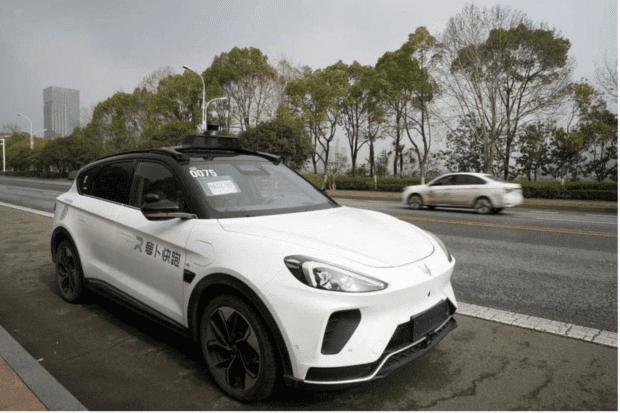Robotaxis ready for hire in Beijing

Beijing has granted licenses to tech giant Baidu to operate fully driverless robotaxi services. PHOTO: REUTERS
BEIJING – The scenes in science-fiction movies of people riding unmanned vehicles are becoming increasingly realistic, demonstrated by the recent availability of robotaxis in Beijing, which can be hired via mobile apps.
The city granted licenses to operate fully driverless robotaxi services to Chinese tech giant Baidu and autonomous vehicle startup Pony.ai, earlier in March. It marked the first time that a fully driverless fleet of vehicles have been allowed to operate in a major city worldwide.
The two companies are among the leading players in China’s autonomous driving industry, who have each deployed 10 autonomous vehicles in a 60sq km area in Yizhuang, a southern suburb of Beijing.
They offer robotaxi services to citizens who can hail a ride through Baidu’s Apollo Go and Pony.ai’s PonyPilot+ apps.
Vehicles operate without a safety driver or human monitor inside. During the journey, passengers can communicate with support specialists verbally to receive assistance inside the vehicle.
The move follows the two companies beginning such road tests in the area on Dec 30. During the tests, Pony.ai said it achieved safety, stability and zero accidents in complex scenarios such as intersections and narrow roads, as well as in extreme weather conditions such as rain, snow and sandstorms.
Beijing set out a three-stage process for autonomous vehicle testing on public roads in 2022.
The first stage involves testing with a human safety driver, the second stage allows for a safety driver in the front seat and a passenger in the back, while the third stage allows for fully autonomous driving without a safety driver.
So far, the designated area in Beijing for autonomous driving has served more than 1 million people with mileage of more than 1.3 million kilometers.
Besides the capital, Baidu’s ride-hailing services cover more than 10 cities in China, including Shanghai and Guangdong province’s Guangzhou and Shenzhen.
The company plans to expand its autonomous ride-hailing services to 65 cities in 2025 and 100 in 2030.
According to a head of Apollo Go, each vehicle can provide more than 15 ride services per day in first-tier cities on average.
As of the end of January, it has accumulated more than 2 million orders, ranking it among the largest autonomous driving service providers in the world.
Global consultancy IHS Markit forecast that the market size of China’s self-driving taxi services is expected to surpass 1.3 trillion yuan ($251 billion) by 2030, accounting for 60 per cent of the country’s ride-hailing market by then.
McKinsey reported that autonomous driving could create US$300 billion to US$400 billion in revenue globally by 2035.
Mr Yale Zhang, managing director at Shanghai-based consultancy Automotive Foresight, said that China’s robotaxi fleet is the world’s leading one, primarily attributed to the immense efforts put forth by companies conducting testing and the establishment of experimental zones by local governments.
Despite current limitations that require robotaxis to operate in designated zones due to complex road conditions and lack of legal shortfalls, their coverage is expected to expand as data accumulates and algorithms improve, Mr Zhang said.
These unmanned vehicles mostly use multiple technologies such as lidar, cameras and ultrasonic sensors to obtain information about the surrounding environment. It then processes and judges through artificial intelligence algorithms to achieve autonomous driving.
The robotaxi is also expected to pave the way for the development of private autonomous vehicles, which have the potential to be a revolutionary technology capable of transforming people’s lives, Mr Zhang said.
Level 2 driving-assist features have become common in new cars. Statistics from the Ministry of Industry and Information Technology show that more than 30 per cent of new passenger vehicles sold in the first half of 2022 had Level 2 driving-assist functions.
However, the large investment, long periods of research and development and delays to large-scale commercialization have shaken the capital market’s patience for autonomous driving.
Waymo, one of the earliest players in the robotaxi race, had seen its valuation plummet from US$175 billion in 2018 to US$30 billion in 2022.
Cruise, the self-driving unit of General Motors lost US$500 million in value in the second quarter of 2022 alone, averaging more than US$5 million in losses per day.
Meanwhile, Ford has disbanded Argo AI, an autonomous vehicle company that it jointly owned with Volkswagen.
Ford CEO Jim Farley said the company now believes the mass deployment of fully self-driving vehicles is “a long way off”.
RELATED STORIES